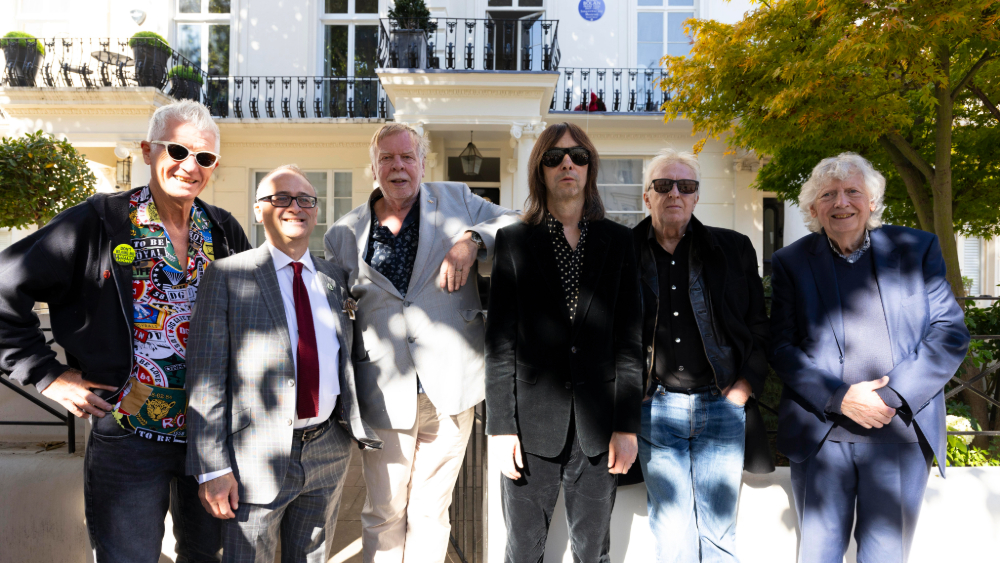On 1 October a group of musicians, historians and music fans gathered outside 18 Bourdon Street in Mayfair, London to celebrate the unveiling of an English Heritage blue plaque. Its recipient? The late pianist, composer, activist, TV personality and PRS member Winifred Atwell.
An innovator, trailblazer and record breaker, in 1954 she became the first Black artist, as well as the first piano instrumentalist, to have a number one single in the UK charts. She would later add another number one to her decorated decades-long career, spending more than 117 weeks in the charts, selling over 20 million records and inspiring countless musicians. The blue plaque unveiling typified the latter point, with the likes of Jools Holland OBE, Sir Richard Stilgoe and Leee John among the special guests there to honour Winifred’s life and career.
Like many early 20th century entertainers, it can be difficult to confirm certain details of Winifred's life. She was born in Tunapuna, Trinidad (various sources give 1910, 1914 or 1915 as her birth year) into a family of conservative, middle-class pharmacists. She excelled academically, so the natural assumption was that she would join the family profession after completing her degree. However, Winifred was also a brilliant pianist. Classically trained from the age of four, she played at Trinidad's Services Club as a young adult, attracting the ears of US servicemen wanting to hear the boogie-woogie styles they missed from 'home'. She learned them all and became hooked herself as word of her musical abilities spread far and wide.
‘It's really unusual because she was hugely famous, Black, from the West Indies, and an incredible pianist by all accounts,’ jazz musician Julian Joseph tells M. ‘She was this prodigious talent; an anomaly.’
Winifred left Trinidad in the early fourties to study with the Russian-American pianist Alexander Borovsky in New York and, by May 1945, she was established enough to play in several concerts at The Town Hall in New York City. Winifred left the US for London in September of that year, the same month she accompanied fellow Trinidadian singer Edric Connor on the BBC's flagship Caribbean show Calling the West Indies. The producers were so impressed by Winifred that they gave her a solo recital broadcast shortly afterwards without audition.
'Winifred was an incredible pianist by all accounts.' - Julian Joseph
Life in London was particularly hard at that time for musicians, but Winifred made ends meet playing jazz and popular music gigs. Theatre and club promoters saw her potential, and she formed a successful piano duo with the theatre organist and composer Donald Thorne. On 21 October 1946, Winifred made her television debut on the BBC talent show Stars in Your Eyes. Despite this, many TV producers still dismissed her as a gimmick and refused to platform her as a 'serious' musician. Winifred did, however, have solid support from those around her. Her husband Lew Levisohn, a former comedian, knew all about show business and became her manager and fiercest advocate.
There are claims that Winifred enrolled at the Royal Academy of Music (RAM), but she doesn't appear in any class records. We do know, though, that she came to London to study with renowned piano teacher and RAM professor Harold Craxton (1885-1971), regularly visiting his house in Hampstead. This space later became Craxton Studios, where her photograph is proudly on display among those of the other musical legends who have played there.
‘I first came across Winifred Atwell at Craxton Studios,’ Nikki Yeoh, who was also present at Winifred’s plaque unveiling, tells M. ‘I saw some pictures of this glamorous Black woman sitting next to a piano. I thought, “Oh, that's interesting. I wonder who that is?”’
Focused on studying classical repertoire, Winifred continued to incorporate more popular styles into her performances as her audience grew. She signed with Decca in 1951 and found commercial success with her rendition of George Botsford's Black and White Rag, selling over one million copies and popularising her ragtime style of playing. BBC TV used this recording from the 1970s as the theme for the long-running snooker show Pot Black.
‘I hadn't realised that the theme tune for Pot Black, which I loved when I was a kid, was played by Winifred,’ Nikki adds. ‘If I'd known that it was played by a woman, that would have been inspiring to me as a young girl playing the piano.’
Winifred's self-penned song Britannia Rag (1952) reached number five in the charts and further cemented her fame. Success continued with popular medleys like Let's Have A Party (1953) and classical pieces like Rachmaninoff's 18th Variation on a Theme by Paganini (1954). She also collaborated with other prominent musicians, including Ted Heath's big band and the Pan Am North Stars Steel Orchestra.
Following a packed-out Royal Albert Hall debut playing Grieg's Piano Concerto in A minor with the London Philharmonic Orchestra and Stanford Robinson in November 1954, Decca agreed to take a few risks. A week later, they reconvened the musicians for the UK's first ever stereo recording. For reasons that remain unclear, though, the concerto was only released on mono and Decca waited another year before repeating their stereo experiment. Winifred's version of Let’s Have Another Party, meanwhile, was released on the day of the Grieg recording session, momentously topping the UK charts in December 1954 and staying there for five weeks. To this day, it is the UK's first and only instrumental Christmas number one.
It wasn’t just Winifred’s records that were in demand — lots of homes still had upright pianos and music fans wanted to play the music they loved. The sheet music business was booming, and Winifred’s compositions were just as popular as her covers. Millions of printed copies were sold.
This success translated into frequent television appearances, including hosting The Winifred Atwell Show on ITV in 1956, and she remained a fixture on British TV for years afterwards. For British-Caribbean families especially, seeing Winifred's face on their screens was something to be proud of. ‘My mother used to refer to her as “Look-Winnie-pon-the-TV”,’ Orphy Robinson MBE, who was representing the organisation Black Lives in Music at Winifred’s plaque unveiling, recalls to M.
Winifred's performance style developed in the age of variety shows. Her on-stage persona was one of glamour and spectacle, often using two contrasting pianos during performances. Some say it was her husband Lew's idea to incorporate a second, broken-down piano for the ragtime songs in her act, though other sources credit Decca for that decision. Whoever it came from, audiences were delighted by it and transfixed by her assured control in any style.
‘It was a mixture of playing boogie-woogie and ragtime,’ Julian explains. ‘It comes from the historic early sounds of jazz [and] players such as Scott Joplin and the famous Meade "Lux" Lewis.’
'Winifred was a Black woman who defied every limitation placed before her and did so with style, intellect and brilliance.' - Orphy Robinson MBE
Winifred first toured Australia in 1955 and permanently settled there with Lew in 1970. Despite being welcomed by the Australian government, Winifred was vocal about racism in Australia, using her privileged status as a celebrity to highlight discrimination and prejudice towards Indigenous Australians. She'd previously utilised her fame in the UK to fight for social justice and uplift those who were being ignored. As well as writing in the US press about race in the UK, Winifred was also praised for opening the UK’s second Black hair salon in Brixton in 1956 — a time when professional Black women had no other options.
Lew’s sudden death in 1977 left Winifred heartbroken. In 1980 she suffered a stroke, and she officially announced her retirement the following year along with plans to permanently return to her native Trinidad. Around this time, Harold Hanlon, a 23-year-old Australian pianist and huge admirer of Winifred's, found her in the phone book. With typical generosity, she invited him to her beachfront home in Narrabeen, Sydney, where Harold grilled her about how she created her signature 'honky-tonk' sound.
‘She explained that all of the strings on the piano lower than the C below Middle C were tuned to concert pitch,' Harold, who also leads the Winifred Atwell Fan Club, tells M. ‘One string from each set of the two and three above that was detuned, and all the remaining strings were tuned to concert pitch. This is how her "other piano" actually sounds out of tune, because the majority of strings were still tuned correctly to concert pitch.’
Winifred remained closely tied to Trinidad, frequently returning to perform and teach. As thanks, she was awarded Trinidad and Tobago's Gold Hummingbird Medal for services to music in 1969. After her death in 1983, her famous 'other piano' made it back to the UK where it's now owned — and still played — by Sir Richard Stilgoe. In September 2024, Trinidad's Queen's Hall Auditorium was renamed as the Winifred Atwell Hall in her memory.
‘She was a supremely talented musician, composer and entrepreneur; a Black woman who defied every limitation placed before her and did so with style, intellect and brilliance,’ Orphy says of Winifred’s legacy. ‘She was a trailblazer, a philanthropist, a scientist and a woman of incredible grace who opened doors by simply being excellent at what she did.’





